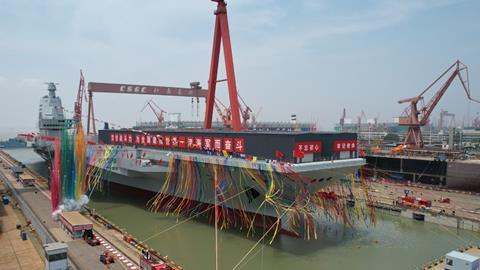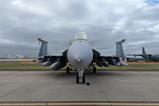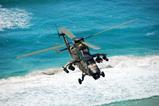The launch of Beijing’s third aircraft carrier, CNS Fujian, was a powerful symbolic moment in China’s relentless arms build-up, with work also under way to forge a world-class air wing.
While the 17 June launch from Shanghai’s Jiangnam shipyard made international headlines, it came as no great surprise for China watchers. In recent years satellite imagery and the rare cellphone picture showed the vessel – known only as ‘Type 003’ before the launch – taking shape, with massive, prefabricated structures coming precisely together.
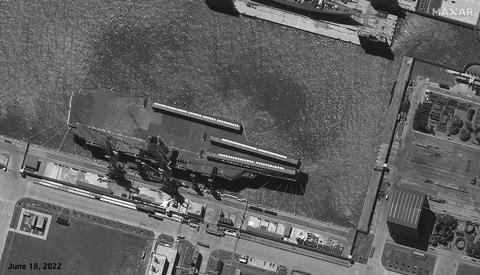
According to the official China Daily newspaper, the Fujian displaces 80,000t. With some pride, it notes that Fujian is the biggest and most powerful warship that any Asian nation has ever constructed.
The vessel is about one-third bigger than China’s first and second carriers, the CNS Liaoning and CNS Shandong. Owing to its trio of electromagnetic launch systems (EMALS), Fujian is a CATOBAR (catapult assisted take-off but arrested recovery) vessel, like US Navy (USN) carriers. The Liaoning and Shandong are STOBAR (short take-off but arrested recovery) vessels that rely on a ski jump to launch fixed-wing aircraft. This restricts aircraft take-off weights and precludes the use of support aircraft.
As a CATOBAR vessel, Fujian will launch combat aircraft such as the Shenyang J-15 and developmental AVIC J-35 with full payloads. In addition, it will be able to launch airborne early warning and control (AEW&C) aircraft in the form of the developmental Xian KJ-600, which resembles the Northrop Grumman E-2 Hawkeye found on US carriers.
“The naming and launch of the Fujian mark a major new step in the development of the People’s Liberation Army Navy [PLAN] aircraft carrier force, because the ship is significantly larger and destined to be significantly more capable than the previous two Chinese carriers, which were essentially variants of an old Soviet design,” says Nick Childs, senior fellow for naval forces and maritime security at the International Institute for Strategic Studies (IISS).
The development and launch of Fujian also reflect China’s realisation that carrier-generated airpower will be a critical element in enforcing its claims in the South China Sea, which it claims as its own in contravention of international law. It could also be of use in a conflict against democratically-governed Taiwan, which China sees as a breakaway province.
Malcolm Davis, senior analyst, defence strategy and capability at the Australian Strategic Policy Institute, notes that Fujian is conventionally – as opposed to nuclear-powered. This suggests that in PLAN service it will focus on the South China Sea and Taiwan.
“For operations in relation to Taiwan and in the South China Sea, a fleet of conventional carriers – both CATOBAR and [STOBAR] – together with [amphibious assault ships] such as the Type 075 and Type 076 which will have a STOVL/ski jump capability as well, will give the PLA real flexibility for conducting a broad range of naval tasks, including supporting landing operations against Taiwan,” he says.
“That is what matters the most in the short term: using Fujian to support counter-air operations against [Taiwan’s air force] from the east, rather than from the Taiwan Straits, allows the PLA to consider more complex operations which are more difficult for the Taiwanese to counter. Likewise, sailing a carrier task force through the South China Sea can more easily assert Chinese control over disputed territories and maritime regions.”
He expects the lessons learned operating Fujian will inform a future fleet of nuclear-powered CATOBAR carriers. Unlike Fujian, these warships will be able to operate far from China’s shores.
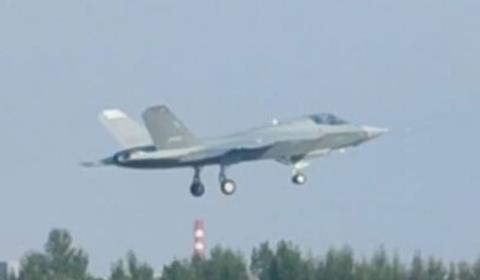
Yet, for Fujian and China’s future CATOBAR fleet to reach this potential, a potent air wing capable of the full range of combat and support missions is required.
Officers on American carriers are fond of stating that the first aircraft launched is the E-2, which provides essential situational awareness for the carrier battle group. Little is known about China’s answer to the E-2, the developmental KJ-600. The AEW&C type has been undergoing test flights since at least August 2020. Seen from a distance the KJ-600 closely resembles the E-2, with twin-turboprop engines, the E-2’s signature tail with four vertical stabilisers, and a large rotodome above the fuselage.
Since the KJ-600’s first appearance, examples have also appeared in satellite imagery of Xian’s main production facility, alongside H-6 bombers and Y-20 strategic transports.
Though many details about the type remain murky, such as whether it has will have an in-flight refuelling probe, the KJ-600 will build on China’s experience with active electronically scanned array (AESA) radars.
Electronics firm CETC has shown a promotional video in which an AEW&C aircraft resembling the KJ-600 uses its KLC-7 AESA to direct an engagement against a US carrier battle group. The KLC-7, says CETC, can track targets at all altitudes, including sea-skimming cruise missiles and ships.
As if the exhausting process of developing an advanced aircraft such as the KJ-600 is not enough, the aircraft will face an arduous integration process aboard Fujian, undergoing hundreds of arrested landings and catapult launchs, in addition to the development of deck handling procedures.
There is speculation that a variant of the KJ-600 will perform the carrier onboard delivery (COD) mission, similar to the role played by the C-2 Greyhound (a derivative of the E-2) and the Bell Boeing CMV-22B Osprey. COD aircraft provide an essential link to the shore, with the capability to transport personnel and high-value equipment including engines and weapons.
On the fighter front, a stealthy model from Shenyang resembling the Lockheed Martin F-35 is in development. Online speculation suggests two aircraft are conducting flight tests following the first example’s maiden sortie in October 2021. The aircraft traces its lineage to the Shenyang J-31/FC-31 prototypes that emerged in the 2010s, and foreign observers have tentatively dubbed it J-XY or J-35. Crucially, it sports a launch bar that will enable catapult shots.
The original J-31/FC-31 was powered by two Klimov RD-33s, but the J-35 is powered by two Chinese WS-19s. The WS-19 is understood to produce 24,700lb (110kN) of thrust, which would make it about 10% more powerful than the GE Aviation F414, the powerplant for the twin-engined Boeing F/A-18E/F Super Hornet.
Given the timelines for developing an advanced fighter, it is likely that the J-35/J-XY will probably enter carrier service only toward the end of the 2020s. Though the programme is shrouded in secrecy, at the 2015 Dubai air show AVIC gave a rare briefing about the FC-31 on which the new fighter is based. The aircraft, which carries weapons internally, was promoted as a low-observable type capable of the full range of fighter missions, from counter-air to deep strike. A video showed FC-31s communicating with each other through secure datalinks.
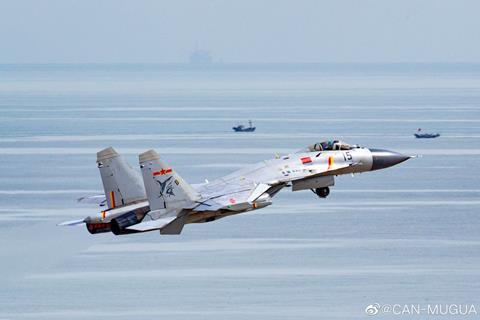
The first fixed-wing aircraft to operate from the Fujian will all but certainly be an advanced version of the J-15, with strengthened landing gear to handle the stresses of catapult shots. The fighter will also feature a new AESA radar. In addition, an electronic warfare (EW) variant designated the J-15D is in development. Instead of the J-15’s signature wingtip missile rails, it has two pods, which likely contain radar warning receivers. It is also expected to carry jamming pods on its underwing stations.
When deployed, the combination of J-15s and J-15Ds will be analogous to the USN’s use of the F/A-18E/F and its EW variant, the EA-18G Growler. In US strike missions, the EA-18G plays an essential role supressing enemy air defences, allowing F/A-18E/Fs to attack defended targets. In addition, the J-15 supplies a crucial tanking role via a centreline buddy refuelling tank.
The Fujian could also deploy unmanned aircraft. A series of small unmanned air vehicles (UAVs) was recently spotted on the deck of Shandong, and UAVs have proliferated in maritime roles in recent years. From a PLAN perspective, a squadron of UAVs aboard a carrier would offer a persistent and cost-effective intelligence, surveillance and reconnaissance capability.
Finally, the Fujian will have a squadron of rotorcraft to support anti-submarine warfare (ASW) and fleet replenishment missions. These missions are likely to be served by the Harbin Z-20, which bears a striking similarity to the Sikorsky S-70. In 2020 images appeared on Chinese social media showing the ASW-roled Z-20F and the utility-roled Z-20J. In US service, the MH-60R undertakes the ASW mission while the MH-60S handles utility work, for example shifting cargo among ships while the fleet is underway.
The Z-20F bears a close resemblance to the MH-60R, including a chin-mounted surface search radar, stub-wings for weapons and other equipment, a dipping sonar, as well as an electro-optical/infrared (EO/IR) sensor mounted in front of the cockpit. The more basic Z-20J lacks these features.
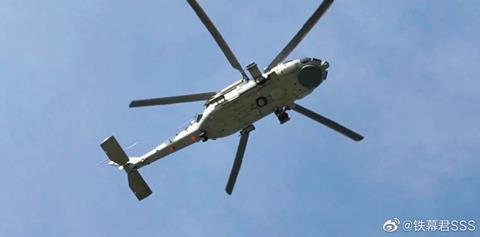
Though not as impressive as the fighters, the Z-20F is arguably among the most important aircraft on the ship given the danger posed by submarines and, increasingly, unmanned underwater vehicles.
“Subs always have been and probably always will be a threat to carrier (and more generally, surface ship) survivability,” says Davis. “The Battle of the Atlantic in World War Two lives on in the next war. The difference we face is a proliferation of unmanned systems that can restore mass to the underwater battlespace, and make it more difficult for carriers to avoid detection – even as they are likely tracked by space and near-space ocean surveillance capabilities.”
He describes a scenario in which extra-large unmanned underwater vehicles are armed with torpedoes and mines, and work alongside crewed submarines. Davis also warns about the increasing prevalence of hypersonic weapons that travel faster than Mach 5. These will greatly complicate the defence of naval vessels.
This means that the Fujian and its future air wing will come of age in an era of rapid military change, where some question the viability of the aircraft carrier. Moreover, observers will closely watch the performance of Fujian’s EMALS catapults – a technology that proved extremely problematic on the first US carrier to use the technology, the USS Gerald R Ford.
“It will still be a number of years before the vessel first becomes operational – probably not before 2025,” says Childs. “Even then, it may take further time before it is fully operational. In the meantime, the carrier will continue fitting out at the shipyard before initial sea trials, probably sometime next year, and initial flying trials, perhaps later next year or early 2024.”
He adds that while the Fujian is nearly as big as US carriers, it likely will not match their capabilities, given that it has three catapults compared to four on US vessels, and only two aircraft lifts – American carriers have three or four lifts.
“The PLAN has amassed a decade of experience of carrier operations,” he adds. “Even so, its deployments remain relatively limited, underscoring just how demanding the creation of a carrier force is, even for China. Still, Beijing seems intent on continuing to invest in this capability, with the likely next step a nuclear-powered carrier, perhaps larger still than the Fujian, that could possibly enter service before the end of the decade.”






















